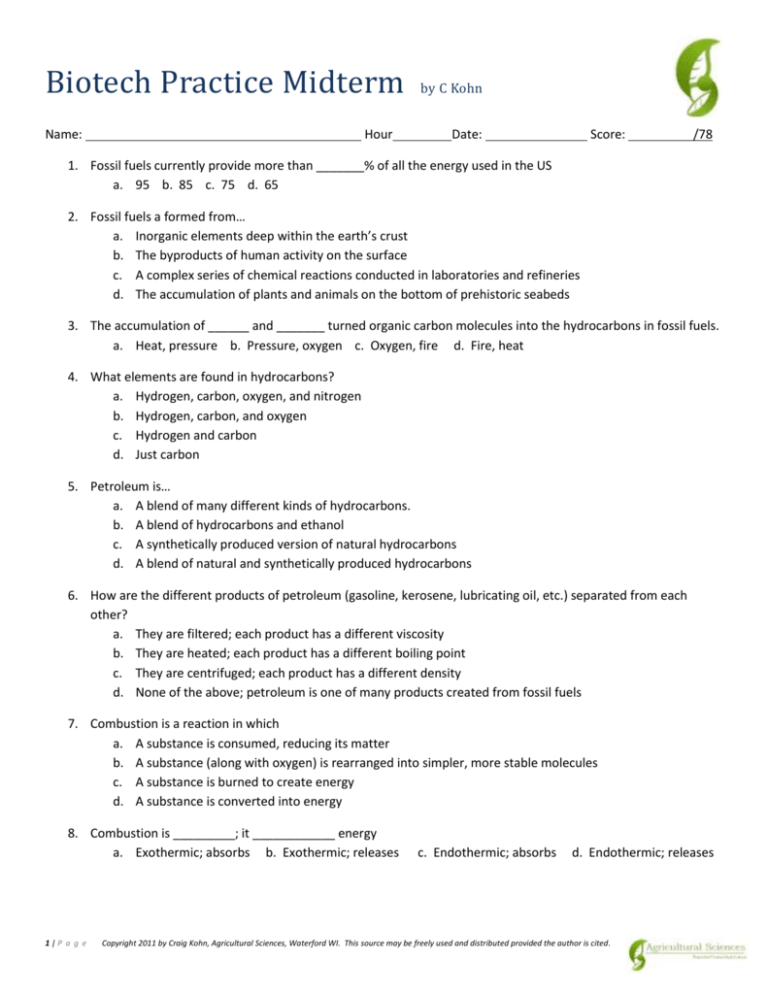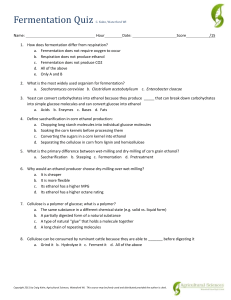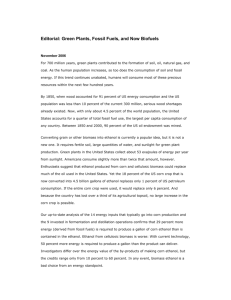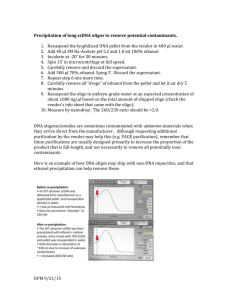Biotech Practice Exam
advertisement

Biotech Practice Midterm Name: Hour by C Kohn Date: Score: /78 1. Fossil fuels currently provide more than _______% of all the energy used in the US a. 95 b. 85 c. 75 d. 65 2. Fossil fuels a formed from… a. Inorganic elements deep within the earth’s crust b. The byproducts of human activity on the surface c. A complex series of chemical reactions conducted in laboratories and refineries d. The accumulation of plants and animals on the bottom of prehistoric seabeds 3. The accumulation of ______ and _______ turned organic carbon molecules into the hydrocarbons in fossil fuels. a. Heat, pressure b. Pressure, oxygen c. Oxygen, fire d. Fire, heat 4. What elements are found in hydrocarbons? a. Hydrogen, carbon, oxygen, and nitrogen b. Hydrogen, carbon, and oxygen c. Hydrogen and carbon d. Just carbon 5. Petroleum is… a. A blend of many different kinds of hydrocarbons. b. A blend of hydrocarbons and ethanol c. A synthetically produced version of natural hydrocarbons d. A blend of natural and synthetically produced hydrocarbons 6. How are the different products of petroleum (gasoline, kerosene, lubricating oil, etc.) separated from each other? a. They are filtered; each product has a different viscosity b. They are heated; each product has a different boiling point c. They are centrifuged; each product has a different density d. None of the above; petroleum is one of many products created from fossil fuels 7. Combustion is a reaction in which a. A substance is consumed, reducing its matter b. A substance (along with oxygen) is rearranged into simpler, more stable molecules c. A substance is burned to create energy d. A substance is converted into energy 8. Combustion is _________; it ____________ energy a. Exothermic; absorbs b. Exothermic; releases 1|P a g e c. Endothermic; absorbs d. Endothermic; releases Copyright 2011 by Craig Kohn, Agricultural Sciences, Waterford WI. This source may be freely used and distributed provided the author is cited. 9. Fossil fuels ___________ energy when combusted because the energy needed to break the bonds of a hydrocarbon is ____________ than the energy give off by the formation of bonds in CO2 and H2O. a. Absorb; greater b. Absorb; less c. Release; greater d. Release; less 10. What is responsible for the smog, soot, and carbon monoxide associated with the use of fossil fuels? a. The hydrocarbon molecule – when completely combusted, there are “leftover” parts that form these pollutants b. The combustion reaction does not fully occur in most cases with hydrocarbons, leaving partial hydrocarbons that form these pollutants. c. The CO2 produced from the hydrocarbons prevents the combustion reaction from starting d. Fossil fuels are dirty because they come from the ground. 11. Biofuels tend to burn _________ than fossil fuels because biofuels burn more _____________ a. Dirtier; slowly b. Cleaner; incompletely c. Dirtier; quickly d. Cleaner; completely 12. Why are atmospheric CO2 levels unnaturally high? a. CO2 is not naturally produced; human activity is adding this molecule to the atmosphere where it never once existed b. CO2 is in the atmosphere because of the hole in the ozone layer c. CO2 used to be produced and used in similar rates; the use of fossil fuels adds CO2 at a rate far faster than it can be reabsorbed d. CO2 levels are not a problem right now 13. How does CO2 cause changes to the Earth’s surface temperatures? a. CO2 absorbs and releases infrared radiation, holding it in the atmosphere longer b. CO2 forms a shield that traps radiation on the Earth permanently c. CO2 produces heat when it breaks down in the atmosphere d. CO2 does not cause an increase in surface temperatures 14. The US accounts for _________% of global carbon emissions despite having only _____% of the world’s population. a. 50; 25 b. 50; 5 c. 25; 10 d. 25; 5 15. Ethanol requires _____________ energy to produce than is released when it is combusted. a. Less b. More c. the same amount of 16. Ethanol produces ____________ carbon dioxide when it is combusted than gasoline. a. Less b. More c. the same amount of 17. A major disadvantage of ethanol is that it…. a. Has a lower gas mileage (vs. fossil fuels); b. Produces more CO2; c. Is less energy efficient; d. All of the above 18. Compared to petroleum diesel fuel, biodiesel is __________ burning, has ______ emissions, and is ______ toxic. a. Cleaner; lower; less b. Dirtier; higher; more c. Cleaner; lower; more 19. A major disadvantage of biodiesel is that even small amounts of __________ will affect the performance of it. a. Oxygen b. CO2 c. Water d. Weight 2|P a g e Copyright 2011 by Craig Kohn, Agricultural Sciences, Waterford WI. This source may be freely used and distributed provided the author is cited. 20. Biofuels are carbon neutral, meaning – a. They don’t produce CO2 b. They produce less CO2 than they absorb c. They produce more CO2 than they absorb d. They absorb the CO2 they release 21. How does a diesel engine convert the energy in fuel into motion? a. The fuel flows past gears that are connected to the axels; the movement of fuel turns the gears. b. The fuel is heated which causes it to expand, pushing against a piston which moves the wheel. As the fluid cools it contracts, pulling the piston with it c. The fuel is compressed, and this compression heats it to the point of combustion. When the fuel combusts, it pushes a piston in a cylinder down, turning the driveshaft. d. The fuel is mixed with air in the cylinder. A spark from a spark plug ignites the fuel-air mixture, causing a combustion reaction which pushes the piston down, turning the drive shaft. 22. What is the main difference between diesel and gasoline engines? a. Diesel fuel is primarily made from renewable sources, while gasoline is not b. Gasoline engines do not produce pollution c. Diesel engines do not produce pollution d. Diesel engines do not have a spark plug 23. What makes a diesel engine so efficient? a. The fact that the air is compressed concentrates the amount of oxygen in the combustion reaction b. Diesel fuel is a more easily combustible fuel c. A diesel engine is made more efficient because of its spark plug d. Diesel engines are more efficient because they can be run on renewable fuel 24. Biodiesel is fuel… a. Made by reacting a plant oil or animal fat with methanol and a catalyst b. Created using the byproducts of ethanol production c. Made from the byproducts of petroleum production d. That can only be used in cold weather 25. What is transesterification? a. A chemical reaction in which an alcohol is converted into an oil or fat b. A chemical reaction in which fat or plant oil is turned into alcohol c. A chemical reaction in which the carbon groups of an oil are broken into straight chains using an alcohol d. A chemical reaction in which glycerin is turned into diesel fuel 26. Which of the following is NOT an advantage of biodiesel? a. It can be used directly in most diesel engine types with only a few modifications b. It is non-toxic and biodegradable c. It is far more energy efficient, releasing over 3x as much energy as is needed to produce it d. It gets higher gas mileage gallon for gallon 3|P a g e Copyright 2011 by Craig Kohn, Agricultural Sciences, Waterford WI. This source may be freely used and distributed provided the author is cited. 27. How much CO2 does biodiesel produce? a. More than it absorbs b. Less than it absorbs c. The same amount as it absorbs d. More than petroleum diesel fuel 28. Which of the following is NOT a disadvantage of biodiesel? a. It will dissolve or corrode certain kinds of metals, rubbers, and plastics b. It is more toxic than petroleum diesel c. It spoils over time d. It requires far more land to produce than is available to meet the nation’s transportation energy needs 29. After the transesterification reaction with oil, what should we see? a. A clear-ish layer of yellow biodiesel on top, with dark glycerin on the bottom b. A clear-ish layer of yellow glycerin on top, with dark biodiesel on the bottom c. A cloudy mix of biodiesel and glycerin d. A batch of biodiesel ready to be put straight into an engine 30. What does it mean to “wash” your biodiesel? a. To allow the biodiesel to sit in the open air as water evaporates from it b. To treat your biodiesel with petroleum diesel fuel to absorb any impurities c. To use glycerin (soap) to remove harmful lipids d. To rinse your biodiesel with water to absorb and remove impurities and un-reacted reagents. 31. What does it mean to “dry” your biodiesel? a. To allow the biodiesel to sit in the open air as water evaporates from it b. To treat your biodiesel with petroleum diesel fuel to absorb any impurities c. To use glycerin (soap) to remove harmful lipids d. To rinse your biodiesel with water to absorb and remove impurities and un-reacted reagents. 32. As biodiesel dries, it should become…. a. Darker b. Clearer c. Cloudier d. Thicker 33. Biodiesel is only a partial solution to the energy needs of our nation because… a. It is less energy-efficient than diesel fuel, releasing less energy than it needs to produced b. Biodiesel does not work without costly and dramatic changes to diesel engines c. It produces more CO2 than petroleum diesel fuel d. Biodiesel requires vast amounts of land to produce enough oil for the transesterification process 34. Biodiesel can become explosive if ___________ materials are used in its production a. Glass b. Wood c. Plastic d. Ceramic 4|P a g e Copyright 2011 by Craig Kohn, Agricultural Sciences, Waterford WI. This source may be freely used and distributed provided the author is cited. 35. The first diesel engine ran on fuel made from a. Petroleum b. Corn c. Soybeans d. Peanuts 36. LCA refers to… a. Living Carbon Assessment b. Life Cycle Analysis c. Limited Carbon Awareness d. Loving Cows Always 37. The addition of an oxygen atom to the structure of a hydrocarbon would have what impact on the combustion of that molecule? a. It would increase gas mileage (or miles driven per gallon) b. It would decrease harmful emissions like soot, smog, and carbon monoxide c. It would require a compression engine instead of an engine with a spark plug d. All of the above 38. Which of the following is shown here: a. Ethanol b. Carbon Dioxide c. Octane (gasoline) d. Methane 39. Which of the following is shown here: a. Ethanol b. Carbon Dioxide c. Octane (gasoline) d. Methane 40. Which of the following is shown here: a. Ethanol b. Carbon Dioxide c. Octane (gasoline) d. Methane 41. Currently, CO2 levels in the atmosphere are at just under… a. 200 ppm b. 300 ppm c. 400 ppm d. 500 ppm 42. Octane, when combusted, will produce how much CO2 per molecule? a. 2 CO2 b. 4 CO2 c. 6 CO2 d. 8 CO2 43. Ethanol, when combusted, will produce how much CO2 per molecule? a. 2 CO2 b. 4 CO2 c. 6 CO2 d. 8 CO2 44. Who is the inventor of the diesel engine? a. Rudolph Diesel b. Randy Gasoline c. Ralph Ethanol d. Rudolph T. Raindeere 5|P a g e Copyright 2011 by Craig Kohn, Agricultural Sciences, Waterford WI. This source may be freely used and distributed provided the author is cited. 45. Ethanol is created through which of the following processes? a. Transesterification b. Respiration c. Fermentation d. All of the above 46. How does the ethanol molecule change if we change the source it is made from? a. Corn ethanol molecules burn more cleanly than cellulose ethanol molecules b. Cellulose ethanol molecules burn more cleanly than corn ethanol molecules c. Corn ethanol molecules burn more completely than cellulose ethanol molecules d. Cellulose ethanol molecules burn more completely than corn ethanol molecules e. None of the above; ethanol molecules are the same regardless of their source 47. Which of the following is the chemical formula for ethanol? a. CH3CH2OH b. C8H18 c. C6H12O6 d. Any of these could be ethanol depending on the source 48. One molecule of sugar will yield ___ molecules of ethanol and ___ molecules of CO2 a. 1;1 b. 2;2 c. 1;3 d. 3;1 49. ____________ energy goes into ethanol to produce it than you get when you combust it. a. Less b. More c. The same amount of 50. An octane rating is… a. A measure of how much energy is contained in a fuel b. A measure of how much a fuel pollutes c. A measure of the emissions of a fuel d. A measure of how efficiently a fuel combusts 51. Cellulosic ethanol could reduce greenhouse gas emissions by what percentage? a. 10-20% b. 30-40% c. 50-60% d. 80-90% 52. The sinking of an ethanol tanker ship (the Bow Mariner) in 2004 caused what major environmental problems? a. Acid Rain b. A dead zone off the coast of Virginia c. Polluted groundwater d. None 53. Which of the following is the easiest to convert into ethanol? a. Cellulosic b. Corn grain c. Sugar Cane d. None of the above; all require the same process 54. A gallon of ethanol contains ____%_ ________________ energy than a gallon of gasoline. a. 5% more b. 5% less c. 34% more d. 34% less 55. A gallon of ethanol has ________________ octane rating compared to gasoline. a. A higher b. A lower c. The same d. A wildly varying 56. Why is most of the ethanol produced in the US made from corn grain? a. It is the easiest crop to ferment into ethanol b. It is the most abundant source of ethanol on the planet c. It is easier to ferment than cellulosic ethanol but more abundant than sugar cane in the US d. All of the above 6|P a g e Copyright 2011 by Craig Kohn, Agricultural Sciences, Waterford WI. This source may be freely used and distributed provided the author is cited. 57. The process of fermenting glucose produces what products? a. Ethanol, CO2, and water b. CO2 and water c. Ethanol and CO2 d. Just ethanol e. Just CO2 58. In ethanol, a feedstock is… a. The ultimate source of ethanol (e.g. corn or sugar cane) b. The type of organism used for fermentation c. The method in which an ethanol crop is harvested d. The byproducts of fermentation that are fed to cattle 59. In the US, most ethanol is made from… a. Sugar Cane b. Cellulosic Sources c. Corn d. Waste vegetable oil 60. Why doesn’t the US produce more of their ethanol from sugar cane? a. It is not as easy to ferment b. It creates more expensive ethanol than corn c. It doesn’t really grow in the US d. All of the above 61. Why is cellulosic ethanol considered the most promising source of biofuel in the future? a. It is the easiest to ferment b. It is the easiest to grow c. It is the most abundant potential fuel source on the planet d. All of the above 62. Which of the following would be a cellulosic crop for ethanol? a. Corn grain b. Sugar cane c. Switchgrass d. All of the above 63. Ethanol pollutes the same as gasoline and takes more energy to produce than you get out of it when combusted. a. True b. False 64. How does fermentation differ from respiration? a. Fermentation does not require oxygen to occur b. Respiration does not produce ethanol c. Fermentation does not produce CO2 d. All of the above e. Only A and B 65. What is the most widely used organism for fermentation? a. Saccharomyces cerevisiae b. Clostridium acetobutylicum c. Enterobacter cloacae 7|P a g e Copyright 2011 by Craig Kohn, Agricultural Sciences, Waterford WI. This source may be freely used and distributed provided the author is cited. 66. Yeast can convert carbohydrates into ethanol because they produce _____ that can break down carbohydrates into simple glucose molecules and can convert glucose into ethanol a. Acids b. Enzymes c. Bases d. Fats 67. Define saccharification in corn ethanol production: a. Chopping long starch molecules into individual glucose molecules b. Soaking the corn kernels before processing them c. Converting the sugars in a corn kernel into ethanol d. Separating the cellulose in corn from lignin and hemicellulose 68. What is the primary difference between wet-milling and dry-milling of corn grain ethanol? a. Saccharification b. Steeping c. Fermentation d. Pretreatment 69. Why would an ethanol producer choose dry-milling over wet-milling? a. It is cheaper b. It is more flexible c. Its ethanol has a higher MPG d. Its ethanol has a higher octane rating 70. Cellulose is a polymer of glucose; what is a polymer? a. The same substance in a different chemical state (e.g. solid vs. liquid form) b. A partially digested form of a natural substance c. A type of natural “glue” that holds a molecule together d. A long chain of repeating molecules 71. Cellulose can be consumed by ruminant cattle because they are able to _______ before digesting it a. Grind it b. Hydrolyze it c. Ferment it d. All of the above 72. Why is cellulosic ethanol so much more difficult to produce than ethanol from corn or sugar-cane? a. Cellulose is wrapped in lignin, which protects it b. Cellulose is wrapped in hemicelluloses, which protects it c. Cellulose has bonds that have different orientations, whereas the orientation of the bonds of starch are all the same d. Cellulose requires more and different enzymes than starch in order to be completely broken down e. All of the above 73. The “unwrapping and unpacking” step of ethanol production from cellulose is known as… a. Biomass Production b. Pretreatment & Hydrolysis c. Sugar Fermentation d. Biofuel Processing 8|P a g e Copyright 2011 by Craig Kohn, Agricultural Sciences, Waterford WI. This source may be freely used and distributed provided the author is cited. 74. What is the most expensive step of ethanol production from cellulosic sources? a. Biomass Production b. Pretreatment & Hydrolysis c. Sugar Fermentation d. Biofuel Processing 75. Which feedstock use would reduce greenhouse gas emissions the most (through its overall LCA)? a. Sugar cane b. Corn c. Cellulosic d. All of the above would be the same 76. Which feedstock would provide the largest available fuel source? a. Sugar cane b. Corn c. Cellulosic d. All of the above would be the same 77. Which step is the biggest obstacle facing cellulosic ethanol? a. Biomass Production b. Pretreatment & Hydrolysis c. Sugar Fermentation d. Biofuel Processing 78. A cow is able to use cellulose as a source of food because it has cellulase-producing microbes in its ______ a. Abomasum b. Omasum c. Reticulum d. Rumen 9|P a g e Copyright 2011 by Craig Kohn, Agricultural Sciences, Waterford WI. This source may be freely used and distributed provided the author is cited.







